Data Markers in UWP Smith Chart (SfSmithChart)
10 May 20217 minutes to read
Data markers are used to provide information about data point to the user. You can add a shape and label to adorn each data point.
Add Shapes
Shapes can be added to line series to indicate each data point and it also can be added to the chart by enabling the ShowMarker option of the Series property. There are different shapes can be added to the chart by using the MarkerType option such as rectangle, circle, diamond, etc.
The following code example explains how to enable series marker and add shapes,
<syncfusion:SfSmithChart x:Name="SmithChart">
<syncfusion:LineSeries ShowMarker="True" MarkerType="Circle">
</syncfusion:LineSeries>
</syncfusion:SfSmithChart>LineSeries series = new LineSeries();
series.ShowMarker = true;
series.MarkerType = MarkerType.Circle;
chart.Series.Add(series);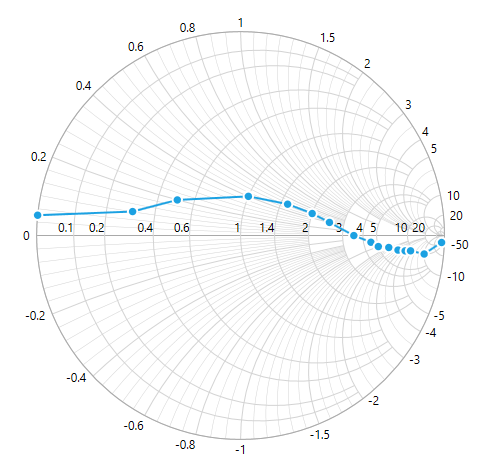
Customizing Marker
The markers interior, stroke, and size can be customized as demonstrated in the below code snippet.
<syncfusion:SfSmithChart x:Name="SmithChart">
<syncfusion:LineSeries ShowMarker="True" MarkerType="Circle" MarkerHeight="12" MarkerWidth="12" MarkerInterior="Red" MarkerStroke="Yellow">
</syncfusion:LineSeries>
</syncfusion:SfSmithChart>LineSeries series = new LineSeries();
series.ShowMarker = true;
series.MarkerType = MarkerType.Circle;
series.MarkerHeight = 12;
series.MarkerWidth = 12;
series.MarkerInterior = new SolidColorBrush(Colors.Red);
series.MarkerStroke = new SolidColorBrush(Colors.Yellow);
chart.Series.Add(series);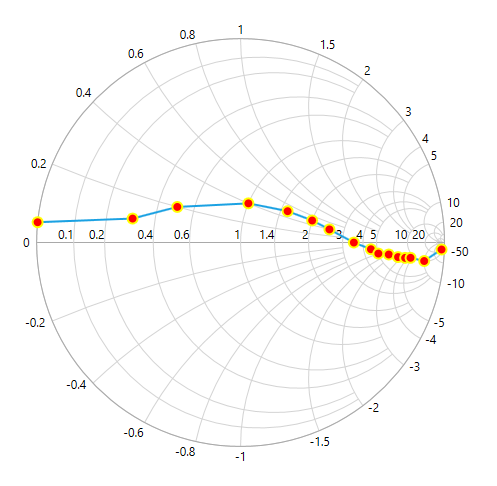
MarkerTemplate
Apart from the shapes, custom shapes also can be added to mark the data point by using the MarkerTemplate property. To add custom shapes, define the MarkerType as Custom.
The following code example illustrates how to add custom shapes,
<syncfusion:SfSmithChart x:Name="SmithChart">
<syncfusion:SfSmithChart.Resources>
<DataTemplate x:Key="Ellipse">
<Ellipse Stretch="Fill" Fill="{Binding Interior}" Stroke="{Binding Stroke}" StrokeThickness="2" Width="10" Height="17" />
</DataTemplate>
</syncfusion:SfSmithChart.Resources>
<syncfusion:LineSeries ShowMarker="True" MarkerType="Custom" MarkerTemplate="{StaticResource Ellipse}">
</syncfusion:LineSeries>
</syncfusion:SfSmithChart>LineSeries series = new LineSeries();
series.ShowMarker = true;
series.MarkerType = MarkerType.Custom;
series.MarkerTemplate = this.Grid1.Resources["Ellipse"] as DataTemplate;
chart.Series.Add(series);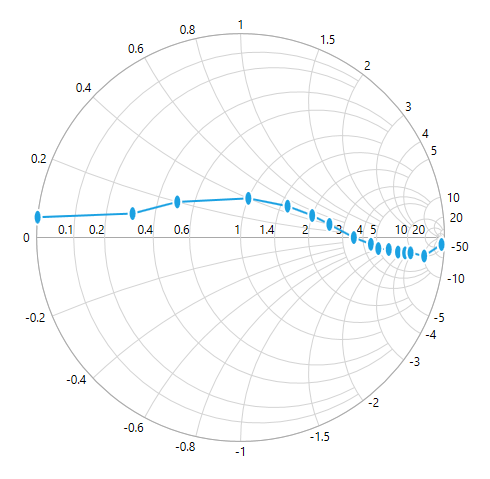
Add Labels
Data label can be added to a chart series by setting the ShowLabel property as True in the series DataLabel option. By default, the data labels are displayed on top of the data point and it can be automatically adjusted its position when collide with another label.
<syncfusion:SfSmithChart x:Name="SmithChart">
<syncfusion:LineSeries ItemsSource="{Binding Data}" ResistancePath="Resistance" ReactancePath="Reactance">
<syncfusion:LineSeries.DataLabel>
<syncfusion:DataLabel ShowLabel="True"></syncfusion:DataLabel>
</syncfusion:LineSeries.DataLabel>
</syncfusion:LineSeries>
</syncfusion:SfSmithChart>LineSeries series = new LineSeries();
series.DataLabel.ShowLabel = true;
chart.Series.Add(series);NOTE
The position changed data label will be connected by using connector line and the label will be hidden if there is no place to position it around the data point.
The following screenshot illustrates how the data labels can be positioned.
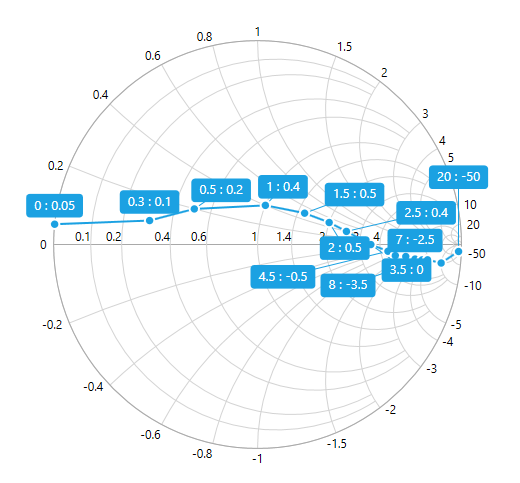
LabelStyle
The style for the data label can be defined by using LabelStyle property of DataLabel.
<syncfusion:SfSmithChart x:Name="SmithChart">
<syncfusion:SfSmithChart.Resources>
<Style TargetType="TextBlock" x:Key="labelStyle">
<Setter Property="Foreground" Value="Yellow"/>
<Setter Property="FontSize" Value="12"/>
<Setter Property="FontFamily" Value="Calibri"/>
<Setter Property="FontWeight" Value="Bold"/>
</Style>
</syncfusion:SfSmithChart.Resources>
<syncfusion:LineSeries>
<syncfusion:LineSeries.DataLabel>
<syncfusion:DataLabel ShowLabel="True" LabelStyle="{StaticResource labelStyle}">
</syncfusion:DataLabel>
</syncfusion:LineSeries.DataLabel>
</syncfusion:LineSeries>
</syncfusion:SfSmithChart>LineSeries series = new LineSeries();
series.DataLabel.ShowLabel = true;
series.DataLabel.LabelStyle = this.Grid1.Resources["labelStyle"] as Style;
chart.Series.Add(series);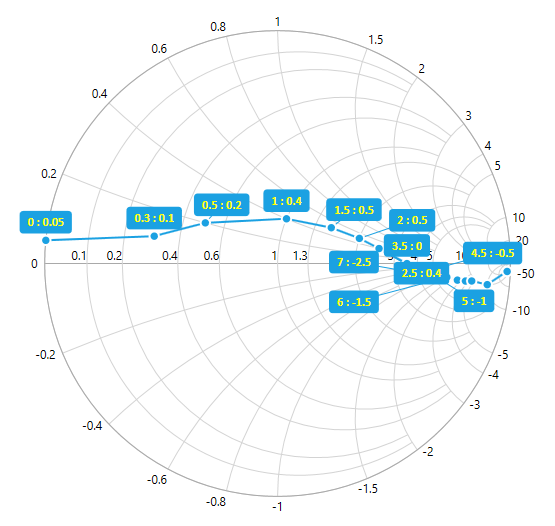
LabelTemplate
The label content can be formatted and customized by using LabelTemplate property of DataLabel. The following code example illustrates how the label content can be formatted and customized.
<syncfusion:SfSmithChart x:Name="SmithChart">
<syncfusion:SfSmithChart.Resources>
<DataTemplate x:Key="labelTemplate">
<Border CornerRadius="4" Background="{Binding Background}" BorderThickness="1" Padding="8,4,8,4" BorderBrush="{Binding BorderBrush}">
<Grid>
<Grid.RowDefinitions>
<RowDefinition/>
<RowDefinition/>
</Grid.RowDefinitions>
<TextBlock Grid.Row="0" Text="{Binding Resistance}" Style="{Binding LabelStyle}"/>
<TextBlock Grid.Row="1" Text="{Binding Reactance}" Style="{Binding LabelStyle}"/>
</Grid>
</Border>
</DataTemplate>
</syncfusion:SfSmithChart.Resources>
<syncfusion:LineSeries ShowMarker="True" ItemsSource="{Binding Data}" ResistancePath="Resistance" ReactancePath="Reactance">
<syncfusion:LineSeries.DataLabel>
<syncfusion:DataLabel ShowLabel="True" LabelTemplate="{StaticResource labelTemplate}"></syncfusion:DataLabel>
</syncfusion:LineSeries.DataLabel>
</syncfusion:LineSeries>
</syncfusion:SfSmithChart>LineSeries series = new LineSeries();
series.DataLabel.ShowLabel = true;
series.DataLabel.LabelTemplate = this.Grid1.Resources["labelTemplate"] as DataTemplate;
chart.Series.Add(series);